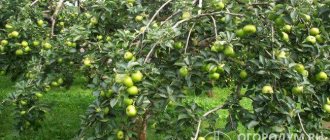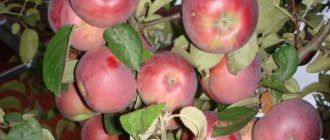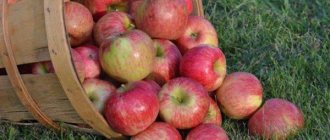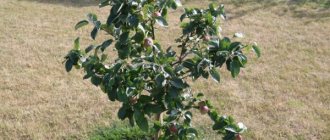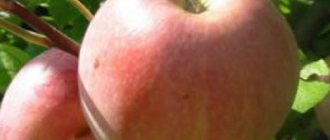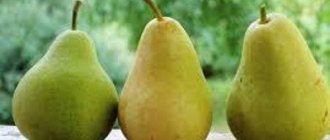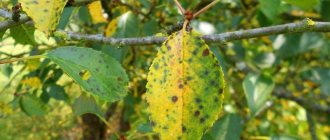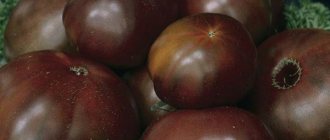The oldest Russian variety, so popular and flexible that it is separated into a separate series, is Antonovka. Although it is rarely planted in new intensive orchards, it still accounts for more than half of the apples collected in the Central zone and in the north of the Black Earth part of Russia. But private farmsteads rarely do without it. The description of the Antonovka variety, photos of the apple tree and reviews show that gardeners on private farms are not going to give up the cultivar, and the demand for seedlings is consistently high.
Types and varieties, appearance
Antonovka is a variety of apples, which is actually a generalized variety that includes numerous varieties, the most popular of which are the following:
- Antonovka vulgaris - considered the founder of the variety, the fruits are medium-sized, bright yellow, with a characteristic sourness;
- Antonovka white - does not tolerate winter very well, the fruits are sour, but they look very beautiful;
- Antonovka Chinese - frost-resistant and scab-resistant, yellow fruits, harvested at the end of October;
- Antonovka-kamenichka - good resistance to frost, fruit rot, scab, a high-yielding variety whose fruits can be stored for a long time;
- Golden monk is a frost-resistant variety, early flowering - the fruits appear in mid-August, are large in size, and fall quickly;
- Dessert Antonovka - the frost resistance of this variety is lower than that of ordinary Antonovka, the fruits are large, green with a red side, sweet and sour;
- Golden Antonovka - tolerates low temperatures well, ripens earlier than other varieties, the fruits have golden skin, the taste is sweeter than ordinary Antonovka;
- Antonovka's daughter (Snowball) - the fruits of this variety have a very thin skin of a whitish color, they are very juicy, slightly tart, harvesting occurs in early September;
- New Antonovka - frost-resistant, but susceptible to scab, the fruits are yellow, sweet and sour;
- Antonovka sweet - the variety has a higher sugar content in the fruits and is unsuitable for storage;
- Puntovka (Antonovka one and a half pound) - frost-resistant and disease-resistant, the fruits are large (up to 0.6 kg);
- Antonovka rusty - resistant to diseases, the fruits are stored for a long time, their color resembles rust.
Antonovka apple tree (see photos of different types of trees below) is a vigorous type of tree; it can reach 5-6 meters in height. The bark is brown, the leaves are oblong and bright green in color, with jagged edges. It blooms with large white inflorescences with a slightly perceptible pink tint. The fruits are endowed with bright taste and magnificent aroma.
Antonovka apple tree (the description of the varieties of which is given above) differs in terms of ripening, type and taste of fruits, degree of frost resistance and disease resistance.
Reviews from gardeners
Semyon, 64 years old, Ivanovo region
Our Antonovka is almost thirty years old. The harvest may not produce for a year, or even two. If the tree blooms in cold spring, then don’t expect many apples. But in fruitful years, the branches break under the weight of fruit. We start collecting in early October, checking the seeds - if they turn brown, you can remove them. The tree is very tall, the top has to be shortened, the branches directed inwards have to be cut down. We store part of the harvest in the basement, in wooden boxes, and process the rest. At the end of December, apples acquire a honey aroma and harmonious taste. The pulp is not very juicy, sweet and sour, and the appearance is not the most beautiful. But the unique Antonov scent, for me personally, is the smell of childhood and home warmth.
Maria, 57 years old, Bryansk
Twelve years ago, after purchasing a summer house, apple trees were planted in the garden. The seedlings were bought at a nursery. Two summer varieties and three winter ones. Among them is “Antonovka Golden”. We harvest at the end of August. Apples do not last long. Ripe fruits look appetizing: bright yellow in color and the barrel appears translucent from the sunny side. The pulp is sweet, crumbly and very pleasant in its own way, but, unfortunately, they do not have the classic acidity and aroma.
Rodion, 51 years old, Tula
I always wanted to have Antonovka in my dacha, that’s why I planted it myself 20 years ago. I don’t take special care of the apple tree, I only dig up the soil at the roots in the fall and spread fertilizer. Harvests have become irregular over the past ten years, but remain plentiful - about 200 kg per tree. Together with my father, we make soaked apples in oak barrels according to old recipes. The taste is indescribable, specific, truly Antonov!
Benefit
The rich chemical composition of Antonovka fruits determines the presence of numerous beneficial properties for the human body. Antonovka apples:
- improve digestion;
- help optimize hemoglobin levels in the blood;
- stimulate kidney activity;
- have a positive effect on the cardiovascular system;
- help strengthen the immune system;
- have a positive effect on the activity of the gallbladder;
- have a strengthening effect on bone tissue;
- have a good effect on the nervous system.
Characteristic
The result of folk selection of the 19th century on the territory of the Kursk province is the famous Antonovka. An apple tree that poses many mysteries not only in its origin, but also in the abundance of varieties. I.V. Michurin emphasized that only 5 varieties can really be called Antonovka. The timing of fruit ripening is also different. They also differ in the duration of storage. Trees growing north of Bryansk, Orel, Lipetsk bear early winter fruits and ripen by mid-September. Apple trees bearing fruit south of this conventional border bear autumn apples in early September.
The Antonovka common apple tree variety is known for its high yields - up to 200 kg. Individual trees produce 500 kg. A record harvest of over a ton was noted. The peculiarity of the tree is to preserve the harvest until harvest; very few fruits fall off. Antonovka remains the main variety for industrial and amateur gardens in the center of the country and the north of the black earth zone. The apple tree is a real long-liver, guaranteed to bear fruit for 30-40 years or more, and grows for over a hundred years.
The first fruits of the Antonovka common apple tree, according to gardeners’ descriptions, are tasted 7-8 years after grafting. It really bears fruit from the age of 10, before that the yield is low, no more than 15 kg. At first, the variety blooms and produces a harvest annually, and with age comes periodicity in fruiting.
The apple tree owes its longevity and productivity to the characteristics of its compact root system. The main, very dense mass is concentrated within 1-1.2 m. This underground center of the tree is located shallow, only 50-70 cm from the surface of the earth. The roots spread deeper and further, but with less density.
Advice! Apple trees with rootstock from Antonovka seedlings are also durable, and their fruiting period is longer than those grafted onto wild apple trees.
Pollination
Like most garden crops, the Antonovka apple tree is among the self-sterile. The varieties are considered the best pollinators
- Anise;
- Pippin;
- Welsey;
- Calville snowy;
- Autumn striped.
Gardeners believe that the apple tree can normally be pollinated by any other varieties. Apple tree Antonovka, according to the description, has an average flowering period.
Fruit quality
The commercial indicators of the variety are high: 15% of the fruits of one apple tree belong to the highest grade, 40% to the first. Antonovka apples tolerate long-distance transportation well, they last for 3 months, treated with antioxidants - four months. The taste and smell become more intense during storage. Sometimes during storage, apples suffer from the disease “tanning” - the color of the skin changes, brown spots appear. The facts apply to winter apples. Those that are collected in the fall, growing south of Bryansk, lie quite a bit. They need to be processed on time.
The Antonovka apple variety is famous for its beneficial properties. The fruits contain many vitamins and minerals necessary for humans, in particular a large percentage of iron. Apples are consumed fresh, baked, or soaked. They make an ancient delicacy - marshmallow, as well as marmalade, jellies, and jams. The apple tree is a favorite of private gardens. Only its fruits are the most delicious for economical preparation: soaking in barrels.
Important! The fruits of Antonovka are from orchards where the soil was alkalized, with denser pulp, and last much longer.
Wood properties
The Antonovka apple tree was bred in a region with unstable, cold winters and summer heat. The tree is frost-resistant and can tolerate short droughts. Characterized by relative resistance to scab, powdery mildew, and fruit rot. In those years when there is a large spread of these diseases, Antonovka also succumbs to them.
The valuable genetic properties of the tree did not go unnoticed. 25 varieties created on its basis are registered. The most famous are Memory of the Warrior, Friendship of Peoples, Bogatyr, Orlovim, Martovskoe and others. And some researchers count more than 200 species of the original variety. The characteristics of this apple tree vary slightly depending on the rootstock and soil properties.
Application
In cooking
In addition to the fact that apples are delicious on their own, you can prepare many dessert dishes from them - jam and marmalade, jelly and marshmallows, marshmallows and jam. Apples are used in baking, added to salads and various other dishes. Juices, compotes, and cider are prepared from apples. Antonovka apples are better suited for soaking than other varieties.
In medicine
In folk medicine, Antonovka is used as an anti-cold and sedative for skin problems.
When losing weight
Since Antonovka fruits are low-calorie, they are used in various diets intended for weight loss.
In cosmetology
The beneficial properties of Antonovka are also in demand in cosmetology - the fruits are used to cleanse, tone, moisturize the skin, and eliminate hyperpigmentation.
Growing in different regions
In the Moscow region and North-West Russia
Here the Antonovka variety is like grapes for Georgia. It has been growing for a long time. They are called differently. Yes, it is not the same everywhere. The garden cannot be imagined without her. And new varieties are being developed.
You can see in the video below that Antonovka in the Moscow region is doing great:
In the Urals and Siberia
It is very widely used, but this is in greenhouses with weak-growing rootstocks and stale forms outside greenhouses. The climate forces us to look for acceptable forms. And clone varieties of Antonovka.
In Ukraine
Only the northern regions (Sumy, Chernigov, Kiev regions) grow it. But it is more like a late autumn variety. And for growing seedlings for grafting.
How to grow, care, pests and diseases
Growing and caring for Antonovka is not at all difficult, so every self-respecting gardener must plant some variety of this apple tree in his garden.
- You can plant a tree in both spring and autumn. In the spring, this is done before the buds begin to bloom on the trees, and in the fall, about two months before the onset of cold weather.
- The place for planting is chosen to be sunny, with moist soil, in which there should be no stagnation of water. The soil should not be very acidic, and it is desirable that it has a high aeration coefficient. The best option is loamy and sandy soil.
- The distance between trees is at least 3-4 m, and between rows - 5-6 m. The seedling is placed in a hole so that the root collar rises 10 cm above the surface. The roots are filled, compacted, a roller is made along the border and poured into hole 2 buckets of water.
- In spring and autumn, the soil in the tree trunk circle needs to be dug up, fertilized and mulched with sawdust.
- Fertilizers are applied three times a year - after the snow melts, before flowering, before fruiting.
- Pruning is done in the spring, 3 weeks before the growing season.
- Antonovka is relatively resistant to various diseases, but is susceptible to scab. Trees are sprayed before flowering with a solution of karbofos or a solution of rovikurt. During the period of bud swelling, spraying with Bordeaux mixture is carried out.
- Antonovka needs pollinators; the best ones are White filling, Pepin saffron, Anise, Welsey.
Features of pollination
The variety is self-sterile, but is considered an excellent pollinator for other varieties of apple trees. Only cross-pollination promotes the appearance of ovaries. To do this, other cultivars are planted next to the seedling. The best neighbors for all varieties of the variety will be:
- Anise;
- Pepin saffron;
- Welsey;
- Autumn striped.
Since pollen is carried by bees, neighbors should be planted at a distance not exceeding the insect's flight radius. In private gardens, seedlings are placed at 5-meter intervals so that the spreading crown does not shade the fruit on neighboring plants.
Whatever Antonovka apple tree you choose, with proper care you are sure to get a rich harvest of fragrant apples.
Preparation and storage
- Antonovka is harvested after the apples are fully ripened, as evidenced by the yellowed peel. The apples are picked by hand, carefully placing them in boxes. If frosts begin and the fruits are not yet ripe, they are collected and allowed to ripen indoors.
- Collected apples are best stored in boxes, carefully lined with straw or paper. Fruits should not be washed before storing. Also, you should not place other fruits nearby. The boxes should be installed in a cool place (for example, a cellar).
- If it is not possible to store apples in boxes, you can resort to this method: put the apples in 5 kg bags, place a walnut-sized cotton wool soaked in alcohol or vinegar in each bag. Punch small holes in the bag.
- The shelf life depends on the area - in the northern regions Antonov apples are stored for up to four months, in the southern regions - up to three.
History of selection
In the records of pomologists, Antonovka vulgaris is listed as a variety bred several centuries ago by Russian folk breeders through long-term cultivation of the descendants of a wild forest apple tree.
On its basis, modern specialists have obtained several popular varieties (A. sweet, A. white, A. one and a half feet) and independent varieties formed by crossing Antonovka vulgaris with other varieties of apple trees (Bogatyr, Cherry, Imrus, Orlovim, Druzhba Narodov).

